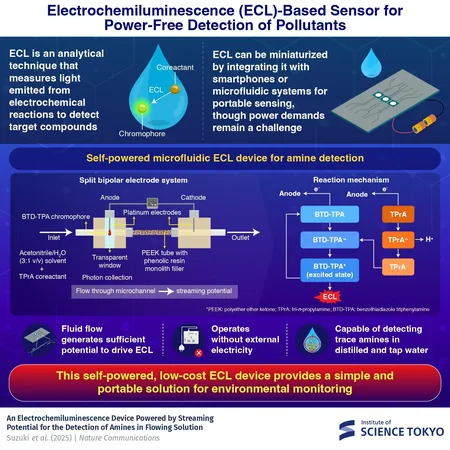
Revolutionizing Water Safety: A Self-Powered Sensor to Detect Toxic Amines
2025-09-09
Author: Wei Ling
A Groundbreaking Innovation in Water Quality Monitoring
As pollution continues to escalate, swiftly assessing water quality has become an urgent necessity. Traditional monitoring systems often entail cumbersome and pricey equipment that can be unfeasible in remote or resource-limited areas.
Self-Powered Detection Technology Unveiled
In an extraordinary breakthrough, scientists at the Institute of Science Tokyo have developed a revolutionary self-powered device capable of detecting toxic amines in water through a method known as electrochemiluminescence (ECL). This innovation generates light during chemical reactions, with the brightness serving as a beacon for potential pollutants, enabling real-time contamination detection.
How It Works: The Science Behind ECL
The ECL mechanism hinges on two essential molecules: a chromophore that emits light and a coreactant that acts as a sacrificial agent. In a series of redox reactions, the chromophore enters an excited state and, upon returning to its ground state, emits visible light, signaling the presence of harmful substances.
Powering Innovation with Natural Flow
Unlike traditional ECL setups that require external power, this new device leverages energy from liquid flow, generating electricity as high as 2-3 volts. This allows the device to operate autonomously, making it a game-changer for ecological monitoring.
Versatile Applications Beyond Environmental Monitoring
The research team, headed by Professor Shinsuke Inagi, envisions a multitude of applications for this technology, including the detection of pollutants in rivers, pipelines, food safety, and even bioweapons. The feasibility of powering the device using natural flow energy opens avenues for efficient pollutant surveillance.
Innovative Design and Functionality
The team engineered a microfluidic system featuring dual chambers with platinum wire electrodes, interconnected through a channel filled with porous material. By utilizing a simple hand-operated syringe, liquid flow generates enough voltage to activate the redox reactions necessary for detecting contamination.
Detecting Toxic Amines: A Critical Need
Amines, known for their toxic and carcinogenic properties, can be found in numerous industrial processes. The device can detect these harmful agents, such as tri-n-propylamine (TPrA), with remarkable sensitivity, identifying concentrations as low as 0.01 millimolar in both distilled and tap water.
Real-World Implications of This Technology
Given its independence from an external power supply, this sensor could be a pivotal tool for real-time pollutant monitoring, particularly in emergency situations where traditional power sources are not available.
Looking Ahead: A Bright Future for Water Quality Monitoring
Professor Inagi expresses optimism about the prototype, suggesting it could represent a low-cost, portable analytical solution harnessing natural electrical energy. The ultimate vision includes utilizing continuous water flow, such as that in rivers, to autonomously power these devices, enhancing global water safety.


 Brasil (PT)
Brasil (PT)
 Canada (EN)
Canada (EN)
 Chile (ES)
Chile (ES)
 Česko (CS)
Česko (CS)
 대한민국 (KO)
대한민국 (KO)
 España (ES)
España (ES)
 France (FR)
France (FR)
 Hong Kong (EN)
Hong Kong (EN)
 Italia (IT)
Italia (IT)
 日本 (JA)
日本 (JA)
 Magyarország (HU)
Magyarország (HU)
 Norge (NO)
Norge (NO)
 Polska (PL)
Polska (PL)
 Schweiz (DE)
Schweiz (DE)
 Singapore (EN)
Singapore (EN)
 Sverige (SV)
Sverige (SV)
 Suomi (FI)
Suomi (FI)
 Türkiye (TR)
Türkiye (TR)
 الإمارات العربية المتحدة (AR)
الإمارات العربية المتحدة (AR)